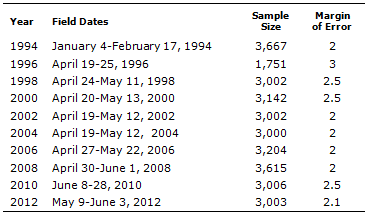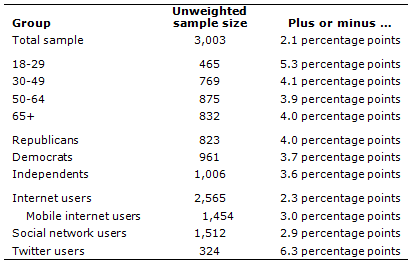The media consumption report draws on a series of large national surveys conducted since 1994. The project was initiated by the Times Mirror Center for the People & the Press in 1994 and continued by the Pew Research Center for the People & the Press since 1996. Over this period, 10 surveys have been conducted, yielding more than 30,000 interviews. All media consumption surveys have been conducted by telephone. Since 2006, cell phone interviewing has been included.
From 1994-2010, interviews were conducted in English only; Spanish language interviewing was added in 2012. Most questions in 2012 were asked of all respondents, but questions about regular media consumption were not asked of those interviewed in Spanish who said they did not consume any media in English.

Results for the 2012 media consumption survey are based on telephone interviews conducted May 9-June 3, 2012, among a national sample of 3,003 adults, 18 years of age or older, living in all 50 U.S. states and the District of Columbia (1,801 respondents were interviewed on a landline telephone, and 1,202 were interviewed on a cell phone, including 591 who had no landline telephone). The survey was conducted by interviewers at Princeton Data Source under the direction of Princeton Survey Research Associates International.
The following table shows the unweighted sample sizes and the error attributable to sampling that would be expected at the 95% level of confidence for different groups in the 2012 survey:

Sample sizes and sampling error for other subgroups are available upon request. In addition to sampling error, one should bear in mind that question wording and practical difficulties in conducting surveys can introduce error or bias into the findings of opinion polls.
Figures in this report may not add to 100% because of rounding. Whites and blacks are non-Hispanic; Hispanics may be of any race.
Survey Methodology in Detail
Sample Design
A combination of landline and cell phone random digit dial samples were used; both samples were provided by Survey Sampling International. Landline and cell phone numbers were sampled to yield a ratio of approximately three completed landline interviews to two cell phone interviews.
The design of the landline sample ensures representation of both listed and unlisted numbers (including those not yet listed) by using random digit dialing. This method uses random generation of the last two digits of telephone numbers selected on the basis of the area code, telephone exchange, and bank number. A bank is defined as 100 contiguous telephone numbers, for example 800-555-1200 to 800-555-1299. The telephone exchanges are selected to be proportionally stratified by county and by telephone exchange within the county. That is, the number of telephone numbers randomly sampled from within a given county is proportional to that county’s share of telephone numbers in the U.S. Only banks of telephone numbers containing three or more listed residential numbers are selected.
The cell phone sample is drawn through systematic sampling from dedicated wireless banks of 100 contiguous numbers and shared service banks with no directory-listed landline numbers (to ensure that the cell phone sample does not include banks that are also included in the landline sample). The sample is designed to be representative both geographically and by large and small wireless carriers.
Both the landline and cell samples are released for interviewing in replicates, which are small random samples of each larger sample. Using replicates to control the release of telephone numbers ensures that the complete call procedures are followed for all numbers dialed. The use of replicates also improves the overall representativeness of the survey by helping to ensure that the regional distribution of numbers called is appropriate.
Respondent Selection
Respondents in the landline sample were selected by randomly asking for the youngest male or female, 18 years of age or older who is now at home (for half of the households interviewers ask to speak with the youngest male first and for the other half the youngest female). If there is no eligible person of the requested gender at home, interviewers ask to speak with the youngest adult of the opposite gender, who is now at home. This method of selecting respondents within each household improves participation among young people who are often more difficult to interview than older people because of their lifestyles, but this method is not a random sampling of members of the household.
Unlike a landline phone, a cell phone is assumed in Pew Research polls to be a personal device. Interviewers ask if the person who answers the cell phone is 18 years of age or older to determine if the person is eligible to complete the survey; interviewers also confirm that the person is not driving and is in a safe place. For those in the cell sample, no effort is made to give other household members a chance to be interviewed. Although some people share cell phones, it is still uncertain whether the benefits of sampling among the users of a shared cell phone outweigh the disadvantages.
Interviewing
Interviewing was conducted at Princeton Data Source under the direction of Princeton Survey Research Associates International. Interviews were conducted in English and Spanish. As many as seven attempts were made to complete an interview at every sampled landline and cell phone number. Calls were staggered over times of day and days of the week (including at least one daytime call) to maximize the chances of making contact with a potential respondent. Interviewing was also spread as evenly as possible across the field period. An effort was made to recontact most interview breakoffs and refusals to attempt to convert them to completed interviews. People reached on cell phones were offered $5 compensation for the minutes used to complete the survey on their cell phone.
Response rates for Pew Research polls typically range from 5% to 15%; these response rates are comparable to those for other major opinion polls. The response rate is the percentage of known or assumed residential households for which a completed interview was obtained. The response rate we report is the American Association for Public Opinion Research’s Response Rate 3 (RR3) as outlined in their Standard Definitions. Fortunately, low response rates are not necessarily an indication of nonresponse bias. In addition to the response rate, we sometimes report the contact rate, cooperation rate, or completion rate for a survey. The contact rate is the proportion of working numbers where a request for an interview was made. The cooperation rate is the proportion of contacted numbers where someone gave initial consent to be interviewed. The completion rate is the proportion of initially cooperating and eligible households where someone completed the interview.
Weighting
First, people with landlines are weighted by household size to account for the fact that people in larger households have a lower probability of being selected. In addition, the combined landline and cell phone sample is weighted to adjust for the overlap of the landline and cell frames (since people with both a landline and cell phone have a greater probability of being included in the sample), including the size of the completed sample from each frame and the estimated ratio of the size of the landline frame to the cell phone frame.
The sample is then weighted to population parameters using an iterative technique that matches gender, age, education, race, Hispanic origin and nativity, region, population density and telephone status and usage. The population parameters for age, education, race/ethnicity, and region are from the Current Population Survey’s March 2011 Annual Social and Economic Supplement and the parameter for population density is from the Decennial Census. The parameter for telephone status and relative usage (of landline phone to cell phone for those with both) is based on extrapolations from the 2011 National Health Interview Survey. The specific weighting parameters are: gender by age, gender by education, age by education, race/ethnicity (including Hispanic origin and nativity), region, density and telephone status and usage; non-Hispanic whites are also balanced on age, education and region. The weighting procedure simultaneously balances the distributions of all weighting parameters at once. The final weights are trimmed to prevent individual cases from having too much influence on the final results.
Weighting cannot eliminate every source of nonresponse bias. Nonetheless, properly-conducted public opinion polls have a good record in achieving unbiased samples. In particular, election polling – where a comparison of the polls with the actual election results provides an opportunity to validate the survey results – has been very accurate over the years.
Sampling Error
Sampling error results from collecting data from some, rather than all, members of the population. The 2012 survey of 3,003 adults had a margin of error of plus or minus 2.1 percentage points with a 95% confidence interval. This means that in 95 out of every 100 samples of the same size and type, the results we obtain would vary by no more than plus or minus 2.1 percentage points from the result we would get if we could interview every member of the population. Thus, the chances are very high (95 out of 100) that any sample we draw will be within 2.1 points of the true population value. The margins of error reported and statistical tests of significance are adjusted to account for the survey’s design effect, a measure of how much efficiency is lost in the sample design and weighting procedures when compared with a simple random sample.




